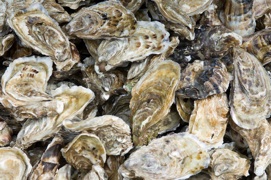
Novel Sensor Research
Graduate Students Developing Novel, Rapid Water-Pollution Sensor A Damariscotta River oyster farmer who lost an entire crop when he was unable to detect a spike in pollutants in the seawater inspired two University of Maine chemistry graduate students to develop a new rapid sensor system to prevent such
occurrences.
Chemistry Ph.D. students James Killarney, who grew up in Aroostook County, and John Ahern of Massachusetts, are working with other UMaine researchers to develop a sensor that uses a novel fluorescence spectrometer to identify changes in concentrations of two common pollutants, nitrates and trihalomethanes (THMs). The spectrometer measures the compounds’ chemiluminescence, or wavelengths of light given off as part of an induced chemical reaction.
Nitrates, which can cause algae blooms, can come from effluent treatment, agricultural fields and aquaculture installations, among other sources. Trihalomethanes are byproducts of chlorine disinfectants used by water treatment plants and ships to purify drinking water and treat effluent. While Killarney and Ahern can program the sensor to monitor for many compounds, they are using nitrates and THMs in the development phase, since nitrate control is critical for aquaculture and the sensor can assess the purity of onboard drinking water or appropriate chlorine levels in ship septic systems. The units will be deployable on buoys or at saltwater farms.
Killarney and Ahern, who have formed a small company, Fluorometrics, will be able to receive an immediate signal remotely from the sensor to a server network that alerts them to a change in water quality. Fluorometrics would contract commercially with clients that could be notified about the change before damage occurs.
Funded primarily by a 2012 Maine Technology Institute seed grant for $13,000, the students’ prototype will be the model for portable sensors that are small, lightweight and inexpensive enough to be used in many of the nation’s 6,000 aquaculture operations, similar operations in Northern Europe and Asia, in addition to drinking water monitoring, the students say. Existing sensing devices that identify nitrates, THMs, dissolved oxygen content and algae in water, are expensive, complex and detail-oriented instruments beyond the financial reach of many farmers trying to establish fish or shellfish businesses.
Most importantly, existing equipment requires water samples to be sent to laboratories for testing, which can take several days or more. The success of their device, they say, lies in its simplicity. Instead of a detailed analysis, aquaculturists “just want to know is my water different?” says Killarney, a U.S. Environmental Protection Agency STAR graduate fellow. UMaine has filed patent applications related to the device and integrated software that enables the analytical process.
“Early detection means early warning, so they can pull their stock before (contaminates) get beyond the legal limit and save the stock,” Killarney says. In the case of Bill Mook, the Damariscotta River oyster farmer whose operation Killarney and Ahern hope to use for beta testing, “he just wanted something to tell him this is the normal variance of what water should look like. Just give me something in real time that says, hey, something’s different in the water right now.”
In 1998, had he known dumping of septic and chemical waste was occurring adjacent to his hatchery seawater intake on the Damariscotta River, Mook says he could have quickly identified the problem and shut down his pumps. “This would have saved hundreds of thousands of dollars in lost production and seven jobs,” he says. The pollutant sensor relies on a new type of fluorescence spectrometer invented by consultant and management team member David LaBrecque, a UMaine engineering physicist and Chemistry Department research associate. The University of Maine filed a provisional patent on the spectrometer in 2010 and filed in 2011 a non-provisional U.S. patent application, according to LaBrecque, who will receive a percentage of any profits made by the use of the spectrometer and intellectual property.
LaBrecque’s circular diffraction spectrometer utilizes an inexpensive CD that diffracts light into bright, rainbow-like rings, which are then processed and converted into spectral data by a computer. Ahern says the device is simple with no moving parts and can significantly decrease the cost of the instrument. Advising the students is chemistry professor Howard Patterson, an expert in fluorescence spectroscopy. Other members of their management team includes Gregory Hall, chief of the chemistry section of the U.S. Coast Guard Academy in Connecticut and an expert in chemometric modeling of environmental samples; Kris Burton, director of technology commercialization in the UMaine Department of Industrial Cooperation who is assisting with business model development, licensing and commercialization; and John Belding, director of UMaine’s Advanced Manufacturing Center. They also are assisted by student interns at the Foster Center for Student Innovation and several UMaine undergraduates. Ahern and Killarney are using the MTI seed money to establish the technical needs of prospective clients who might use their water monitoring services, to create a business plan and to develop the sensor prototype itself. They also intend to appeal for National Science Foundation funding to continue their work, which runs parallel to their academic interests and will be a part of their theses. Ahern is studying the fluorescence of oils in water and Killarney, who spent seven years in the biopharmaceutical industry, is studying personal care products and pharmaceutical fluorescence.
Both say they are fortunate to have found a marketable solution for an industry problem and start a Maine-based company as part of the process.
Contact: George Manlove, (207) 581-3756
